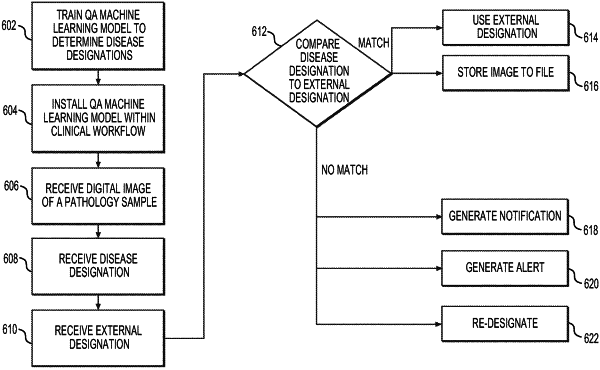| CPC G06T 7/0014 (2013.01) [G16H 30/40 (2018.01); G16H 50/20 (2018.01); G16H 70/60 (2018.01); G06T 2207/10056 (2013.01); G06T 2207/20081 (2013.01); G06T 2207/30024 (2013.01); G06T 2207/30168 (2013.01)] | 20 Claims |

|
1. A computer-implemented method for processing electronic images, the method comprising:
receiving a digital image corresponding to a target specimen associated with a pathology category, wherein the digital image is an image of human or animal tissue and/or an image algorithmically generated to replicate human or animal tissue;
determining a quality control (QC) machine learning model, the QC machine learning model being configured to predict a quality designation based on a presence or lack of one or more artifacts and/or;
providing the digital image as an input to the QC machine learning model;
receiving the quality designation associated with the digital image as an output from the QC machine learning model;
determining, based on the output from the QC machine learning model, whether the quality designation is either an approved designation or a rejected designation, wherein the quality designation is indicative or artifacts such as errors or imperfections in the digital image, wherein the quality designation includes an approval scale and/or a rejection scale that provides a finer indication of the image quality;
determining a quality assurance (QA) machine learning model configured to predict a disease designation based on one or more biomarkers, the QA machine learning model being different than the QC machine learning model;
providing the digital image to the QA machine learning model;
receiving a disease designation for the digital image as an output from the QA machine learning model;
receiving an external designation for one of the digital image or the target specimen and comprising a disease property selected from at least one of a cancer detection, a cancer grade, a cancer origin, a diagnosis, a presence or absence of a microorganism, a specimen type, a cancer type, a cancer status, a tumor size, a lesions risk level, or a grade;
evaluating the external designation by comparing the disease designation to the external designation;
outputting a comparison result based on evaluating the external designation by comparing the disease designation to the external designation; and
rejecting the external designation based on the evaluation, based on the external designation deviating from the disease designation beyond a predetermined threshold.
|